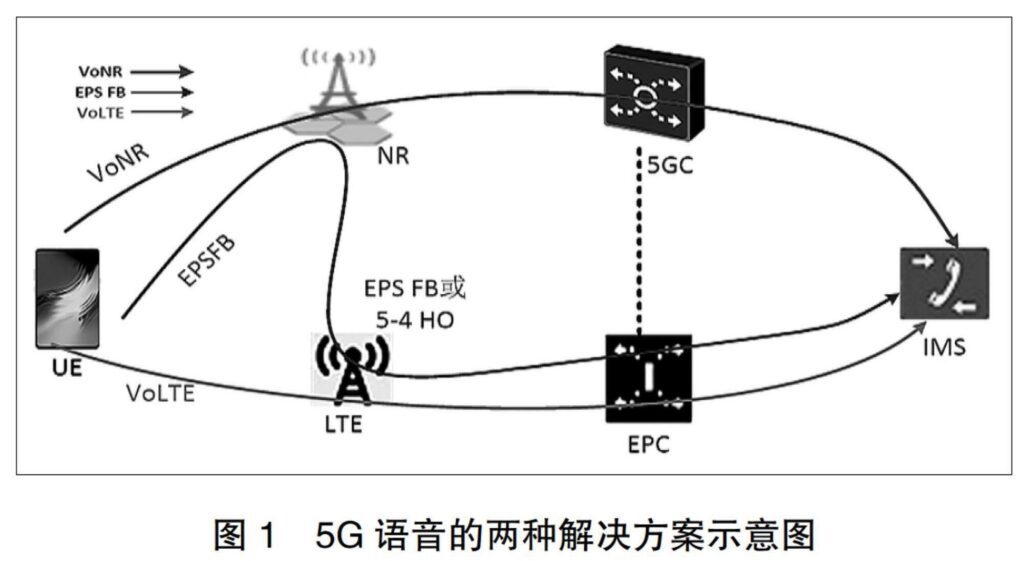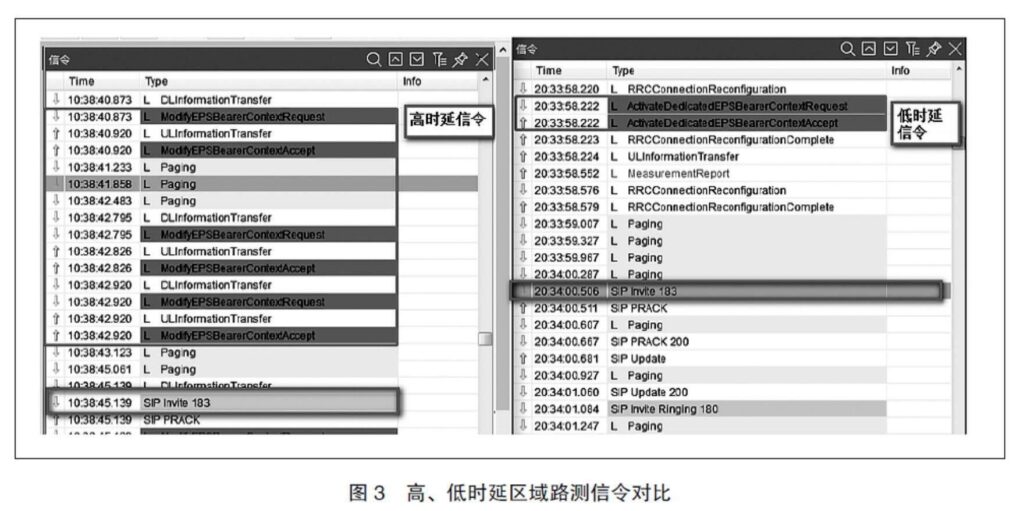In response to the problem of high delay of 5G voice continuation, this article starts from the TOP community and TOP area. Through the combination of front-end road test and background analysis, it deeply analyzes the 5G voice dropback, connection and segmented signaling process, and uses comparative analysis to locate the four key factors affecting the delay of 5G voice continuation. Then, 5G voice delay optimization measures were studied from the three aspects of fall strategy, 4/5G multi-network multi-frequency collaboration and functional deployment, and the 5G voice delay optimization strategy system was summarized and formed, and finally the reasonable effect was verified and promoted in the current network.
I. Introduction
The 3GPP R15 standard stipulates that 5G voice follows the voice architecture of 4G VoLTE [1], and 5G exists as an access method to the IMS network. Between the current weak 5G coverage, technical support, terminal functions and other factors, there are two solutions for 5G SA network voice – transition scheme EPS FB (EPS Fallback) and mature scheme VoNR (Voice over NR) [2]. Figure 1 is The implementation method of 4G voice VoLTE, 5G voice EPS FB and VoNR. Among them, VoNR and VoLTE are both completed by a single network; EPS FB initiates calls from 5G to 4G.
EPS FB is a way for 5G users to return to the 4G network when conducting voice business and use VoLTE to continue voice business. It is a transitional scheme formulated by comprehensively considering the continuity needs of voice services, the discontinuity of 5G network deployment, terminal functions and other factors. It is also the current voice The main carrying scheme.
VoNR is a full-IP voice scheme in the 5G era formulated through the docking of 5G network (“wireless network + core network”) and IMS network, and is also a 5G network voice target construction scheme.
Since the commercialization of the 5G SA network, users’ experience in data business has made a qualitative leap. However, in view of the discontinuity of 5G coverage and the low support rate of VoNR terminals, in terms of voice, more than 80% of 5G users still use EPS FB, and the continuous delay has increased from 2.5s to 5s of ordinary VoLTE, which seriously affects user perception and satisfaction.
II. Factors affecting the delay of 5G voice end-to-end continuation
5G voice end-to-end call delay refers to the delay between sending Invite and receiving 180 Ringing [3]. In order to accurately locate the reasons for the extension of 5G voice end-to-end connection time, this article starts from the high-time delay poor quality community and the TOP area, cooperates with the two majors of wireless and core network, and summarizes the following four main reasons affecting the delay of the continuation through the front-end network test and background signaling.
(I) Switch to redirect
The EPS FB function supports three dropback methods of “measurement switching”, “measurement redirection” and “blind redirection”. EPS FB based on measurement switching needs to carry out B1 measurement and 4G neighborhood, and drop back 4G in the form of switching; EPS FB based on measurement redirection needs to carry out B1 measurement and configuration. 4G neighborhood, redirect to 4G through the dropback frequency point; EPS FB based on blind redirection does not need to be measured by B1, nor does it need to configure 4G neighborhood, and redirects directly to 4G through the dropback frequency point.
In order to improve the success rate of EPS FB’s drop-back connection, it is necessary to select the optimal community for drop-back. The current network mainly focuses on “measurement switching” and supplemented by “blind redirection”. In the process of voice dropback, if there are problems such as high gate limit setting, missing configuration in neighboring areas, weak coverage, etc. on the 4G side, UE cannot report the test report MR or switching failure in time. After the timer timeout, the switching to redirection process will be triggered, and the delay will increase by about 1000ms.
(II) Unreasonable frequency priority
Due to the complex structure of the 4G network, each community is equipped with about 10 drop frequencies and corresponding priorities. When measuring and switching EPS FB, if the signal is not measured due to weak coverage of the highest priority frequency, failure and other reasons, the terminal will continue to measure the second priority frequency point, and the delay of each additional frequency point will increase by about 400ms. For blind redirected EPS FB, if the terminal fails to fall back to the highest priority frequency point, a re-search will be initiated, resulting in an increase in the call delay.
(III) Second fall
In order to ensure the connection rate of voice, when the mobile phone initiates an EPS FB call, if the IMS does not receive the caller SBC response within 6s or the 6S~20S caller does not receive the 183 response sent by the caller or the creation of voice service carrier is not completed within 10s, it will automatically trigger the CSFB secondary return. Fall, the continuous delay is 6 to 10s more than the normal fall. Because the caller does not receive any response during the fallback period, it is often mistaken for the inability to connect, which seriously affects the user’s perception.
(IV) The processing process of IMS core network is unreasonable
Voice call connection requires core network processing and forwarding. By comparing the signaling processes of different 5GC and IMS network elements, it can be found that there is a large delay difference between core network elements. Among them, in the segmentation delay stage of “caller Gm interface and caller Mw interface” [4], the delay difference between caller SBC forwarding processing is about 270ms. Then, continue to analyze the SIP signaling list in depth, and locate the difference between domain selection and location update delay in the “INVITE to 183” stage is about 190ms. Through the assisted analysis of the IMS core network, it can be found that some IMS network elements have not turned on pre-paging, RX parallel and other functions [5], resulting in regional delay differences.
III. 5G voice end-to-end continuous delay optimization strategy and current network application effect
In view of the above factors affecting the delay of 5G continuation, through signaling analysis and network testing, this paper conducts research on the continuous delay and drop strategy from the three aspects of drop strategy, 4/5G multi-frequency collaboration and function deployment. It summarizes a number of optimization measures such as drop strategy, 4/5G multi-frequency collaboration and functional deployment, and Pilot and promotional use has been carried out.
(I) Optimization of fall strategy
1. Optimization of fall mode
For the subdivision 1935 where the 5G station has a large spacing, 5G without 4G areas, 4/5G weak coverage and other continuous time delays is greater than 5s, the dropback mode is changed from “measurement switching” to “blind redirection” to avoid the introduction of additional delays in the switching and redirection process triggered by over-overlay, neighboring area omission, etc. After optimization, the average continuous decrease was reduced from 6403ms to 5941ms, and the delay was improved by 462ms.
2. The priority of the fall frequency point
Unreasonable priority configuration of the fallback frequency point will cause users to carry out multiple frequency point measurements, switching redirection, second dropback, etc. because the optimal frequency point is not measured during the fall, and the increase time delay is about 400ms to 6000ms. According to the frequency point priority configuration “three-step method”, the frequency point priority is adjusted in 1197 places in the high-time delay poor quality community of EPS FB in the whole network. The serial delay of the caller EPS FB is reduced by 179ms, and the success rate of EPS FB drop is increased by 0.07%.
3. Simple redundant frequency points
Too many 4G dropback frequencies will lead to an increase in measurement time. By optimizing the 4G network structure, forming urban FDD1800 and rural FDD900 bottom network structures, and simplifying the 3,186 communities of redundant frequency points in the existing network according to the drop frequency, and the delay can be reduced to 96ms.






(II) 4G/5G multi-frequency collaborative optimization
The EPS FB process involves 4G/5G network, and the quality of 4G network is one of the main factors affecting the delay of EPS FB. Through 4G/5G multi-frequency collaboration such as EPS FB B1 gate limit down search and 4G word number stratification, the EPS FB connection delay can be reduced.
1. EPS FB gate limit down probe
For the 4G weak coverage area, according to the coverage rate and coverage scenario, without affecting the success rate of the fall, the EPS FB B1 event RSRP gate limit is lowered by 3-5dbm to increase the probability of falling back to the highest priority frequency point to reduce the measurement time of multiple frequency points. At the same time, the high-delay community with 4G MR coverage rate <90% and the drop mode is “measurement switching” at 4557, the EPS FB caller is improved by 102ms after the gate limit is down.
2. 4G Language Layering Strategy Optimization
In order to avoid the EPS FB falling back to the F frequency point under the same coverage scenario as F and FDD900, the trigger is the number of words to switch to FDD to increase the delay, sort out the continuous delay >6s and the total station 4G exists in the F and FDD900 scene cells 214, and the FDD900 and F are returned to the priority. All are set to the highest, and the number of words is stratified to A4 from -106 to -100dbm. After comparison, it is found that the delay is reduced by 96ms.
(III) Function deployment
1. EPS FB dropback frequency point advance measurement function deployment
Due to the long time of establishment of idle voice carrier, it is necessary to focus on the timing of the measurement and control task of EPS FB switching back and falling scenes. First of all, when the idle state EPS FB call reason is Voice or Video, turn on the EPS FB fall pre-measurement switch EPSFallbackCtrl.EPS FBEarlyMeasSwch, and send the voice fall B1 measurement task in advance. Then, after the 5QI1 dedicated rejection, the EPS FB processing process can be initiated, and the base station can process the measurement issuance and 5QI1 rejection process in parallel to shorten the delay overhead of EPS FB voice drop. Finally, select a grid as the verification target, turn on the EPS FB drop for all 127 sites in the grid, and measure the switch in advance. After comparison, the EPS FB caller average connection before and after the function is turned on, and the average connection is improved by 186ms.
2. IMS core network process optimization
By comparing the signaling processes of different 5GC and IMS network elements, it can be found that before the “sip invite 183” signaling, there are 3 more “ModifyEPSBearerContextRequest” messages in the high delay area and the low delay area, adding delay 2 About 00ms.
For a detailed analysis and comparison of the additional “ModifyEPSBearerContextRequest” messages, it can be found that the proportion of UE connection state in the high delay area is only 30%, while the proportion of UE connection state in the low delay area is as high as 90%, and the UE will increase under the idle state. Delay in the domain selection and location update stages. Therefore, the IMS core network element turns on the pre-paging function and the RX parallel function, and multi-process parallel execution by calling users in the idle state in advance. After comparison, before and after opening, the continuous delay of EPS was reduced from 3978ms to 3641ms, improving 337ms.
After the above multiple strategies are optimized layer by layer, the 5G voice EPS FB end-to-end delay has decreased from 5180ms to 2985ms, and the VoNR end-to-end delay has decreased from 2436ms to 2087ms, effectively improving 5G user perception.
IV. Conclusion
This article takes the high-delay TOP community and TOP area as the grasp. Through the combination of front-end test and background analysis, the 5G voice delay optimization strategy is developed from point to point and applied to the current network, which greatly reduces the 5G voice continuous delay, effectively solves the abnormal problem of fallback, and improves 5G voice. User perception. The implementation of the strategy proposed in this article is simple and the process is clear, which can be widely promoted and applied.


